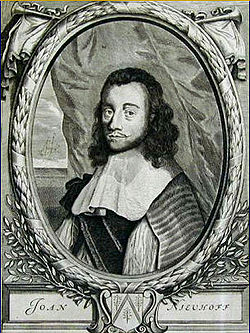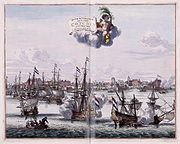
Johan Nieuhof
Encyclopedia

Brazil
Brazil , officially the Federative Republic of Brazil , is the largest country in South America. It is the world's fifth largest country, both by geographical area and by population with over 192 million people...
, China
China
Chinese civilization may refer to:* China for more general discussion of the country.* Chinese culture* Greater China, the transnational community of ethnic Chinese.* History of China* Sinosphere, the area historically affected by Chinese culture...
and India
India
India , officially the Republic of India , is a country in South Asia. It is the seventh-largest country by geographical area, the second-most populous country with over 1.2 billion people, and the most populous democracy in the world...
. The most famous of these was a trip of 2,400 km from Canton
Guangzhou
Guangzhou , known historically as Canton or Kwangchow, is the capital and largest city of the Guangdong province in the People's Republic of China. Located in southern China on the Pearl River, about north-northwest of Hong Kong, Guangzhou is a key national transportation hub and trading port...
to Peking in 1655-1657, which enabled him to become an authoritative Western writer on China.
Biography
Johan Nieuhoff was born in Uelsen, of which his father (originally from ZwolleZwolle
Zwolle is a municipality and the capital city of the province of Overijssel, Netherlands, 120 kilometers northeast of Amsterdam. Zwolle has about 120,000 citizens.-History:...
) was mayor. Nieuhoff left for Brazil in 1640 as a reserve officer-candidate - from then on, barring two short family visits in 1658 and 1671, he spent all the rest of his life abroad. After an adventurous career in the service of the Dutch East India Company
Dutch East India Company
The Dutch East India Company was a chartered company established in 1602, when the States-General of the Netherlands granted it a 21-year monopoly to carry out colonial activities in Asia...
(or "VOC") - between 1660 and 1667 he occupied posts in India
India
India , officially the Republic of India , is a country in South Asia. It is the seventh-largest country by geographical area, the second-most populous country with over 1.2 billion people, and the most populous democracy in the world...
and on Ceylon - he then lived in Batavia
Jakarta
Jakarta is the capital and largest city of Indonesia. Officially known as the Special Capital Territory of Jakarta, it is located on the northwest coast of Java, has an area of , and a population of 9,580,000. Jakarta is the country's economic, cultural and political centre...
until 1670. He then disappeared without trace on Madagascar, after landing from a sloop in order to seek drinking water.
In the first half of the 17th century, the VOC tried to break the Portuguese monopoly position on trade to Macau
Macau
Macau , also spelled Macao , is, along with Hong Kong, one of the two special administrative regions of the People's Republic of China...
. When they did not succeed, they sent four embassies to Beijing between 1655 and 1685. The reports from these embassies and the reports of the Jesuits
Jesuit China missions
The history of the missions of the Jesuits in China is part of the history of relations between China and the Western world. The missionary efforts and other work of the Society of Jesus, or Jesuits, between the 16th and 17th century played a significant role in continuing the transmission of...
formed the only reliable source of information on China available in Western Europe. As purser of the VOC embassy to Peking Johan Nieuhof in 1655 had special instructions to observe all "farms, towns, palaces, rivers, ... [and other] buildings" that he might pass by, drawing them "in straight form and figure", as well as remains of the historical victory of the "Tartars" (Manchus) that brought an end to the reign of the Ming dynasty
Ming Dynasty
The Ming Dynasty, also Empire of the Great Ming, was the ruling dynasty of China from 1368 to 1644, following the collapse of the Mongol-led Yuan Dynasty. The Ming, "one of the greatest eras of orderly government and social stability in human history", was the last dynasty in China ruled by ethnic...
.
At his homecoming in 1658, he had entrusted his notes and annotations to his brother Hendrik, whom Johan thanked when finally (in 1665) Hendrik produced an ample study of China, with many images, text and explanation of the latest events. Hendrik dedicated the work to Hendrik Spiegel
Hendrik Laurenszoon Spiegel
Hendrik Laurenszoon Spiegel was one of the most important writers and thinkers of the Amsterdam of the second half of the sixteenth century....
and Cornelis Jan Witsen
Cornelis Jan Witsen
Cornelis Jansz. Witsen was a counsellor and mayor of the city of Amsterdam. He was the father of Nicolaes Witsen and the son of Jan Witsz and Grietje Claes....
(Nicolaes Witsen
Nicolaes Witsen
Nicolaas or Nicolaes Witsen was mayor of Amsterdam thirteen times, between 1682-1706. In 1693 he became administrator of the VOC. In 1689 he was extraordinary-ambassador to the English court, and became Fellow of the Royal Society. In his free time he was cartographer, maritime writer, and an...
's father), administrators of the East and West India Companies respectively. In Nicolaes Witsen's "Scheepsbouw" (1671), we see more of Nieuhoff's material, on Chinese ships.
Translations into French (1665), German (1666), Latin (1668) and English (1669) were also published, each going into at least two editions.
The 150 illustrations were one inspiration for chinoiserie
Chinoiserie
Chinoiserie, a French term, signifying "Chinese-esque", and pronounced ) refers to a recurring theme in European artistic styles since the seventeenth century, which reflect Chinese artistic influences...
, which became especially popular in the 18th century. Many artists and architects based their designs on the pictures in Nieuhoff's book. The original drawings were rediscovered in 1984 in the collection of prince Roland Bonaparte
Roland Bonaparte
Roland Bonaparte, 6th Prince of Canino and Musignano was a French prince and president of the Société de Géographie from 1910 until his death.-Biography:...
, an anthropologist who collected material about Madagascar, Lapland and the Native Americans.
Works
- Het Gezandtschap der Neêrlandtsche Oost-Indische Compagnie, aan den grooten Tartarischen Cham, den tegenwoordigen Keizer van China: Waarin de gedenkwaerdigste Geschiedenissen, die onder het reizen door de Sineesche landtschappen, Quantung, Kiangsi, Nanking, Xantung en Peking, en aan het Keizerlijke Hof te Peking, sedert den jaren 1655 tot 1657 zijn voorgevallen, op het bondigste verhandelt worden. Beneffens een Naukeurige Beschrijvinge der Sineesche Steden, Dorpen, Regeering, Weetenschappen, Hantwerken, Zeden, Godsdiensten, Gebouwen, Drachten, Schepen, Bergen, Gewassen, Dieren, etcetera en oorlogen tegen de Tartars. 5th edition, Amsterdam: Wolfgang, Waasberge, Boom, van Somerten, and Goethals, 1693.

- Zee- en Lant-Reise door verscheide Gewesten van Oostindien, behelzende veele zeldzaame en wonderlijke voorvallen en geschiedenissen. Beneffens een beschrijving van lantschappen, dieren, gewassen, draghten, zeden en godsdienst der inwoonders: En inzonderheit een wijtloopig verhael der Stad Batavia. Amsterdam: de Weduwe van Jacob van Meurs, 1682.
- Gedenkweerdige Brasiliaense Zee- en Lant-Reise und Zee- en Lant-Reize door verscheide Gewesten van Oostindien. Amsterdam: de Weduwe van Jacob van Meurs, 1682.
External links
- Johan Nieuhoff's Drawings of China
- Die Gesantschaft der Ost-Indischen Geselschaft in den Vereinigten Niederländern an den Tartarischen Cham und nunmehr auch Sinischen Keise.. by Johan Nieuhof, 1666.
- http://www.digischool.nl/ckv2/burger/burger17de/nieuhof.htm
- http://www.iisg.nl/collections/akademiebibliotheek/papers/nieuhof.php#top
- http://digital.library.wisc.edu/1711.dl/DLDecArts.NieuhofNieuhof, Johannes, 1618-1672 / "An embassy from the East-India Company of the United Provinces, to the Grand Tartar Cham, emperor of China: delivered by their excellencies Peter de Goyer and Jacob de Keyzer, at his imperial city of Peking wherein the cities, towns, villages, ports, rivers, &c. in their passages from Canton to Peking are ingeniously described by John Nieuhoff]; ... Englished and set forth with their several sculptures by John OgilbyJohn OgilbyJohn Ogilby was a Scottish translator, impresario and cartographer. Best known for publishing the first British road atlas, he was also a successful translator, noted for publishing his work in handsome illustrated editions.-Life:Ogilby was born in or near Killemeare in November 1600...
" (1673)

